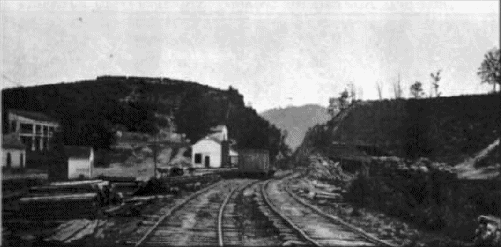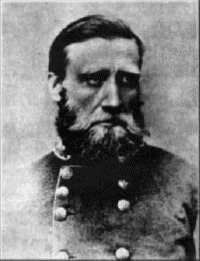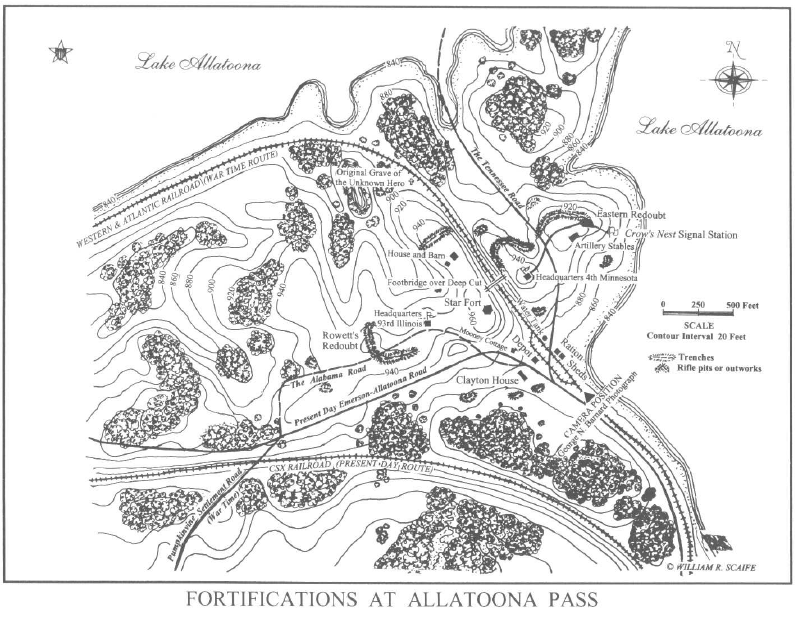[mappress mapid=”26″]Text prepared by William R. Scaife, author of Allatoona Pass: A Needless Effusion of Blood.
Bordering the western shore of Lake Allatoona and the Emerson-Allatoona Road, 1.5 miles east of I-75 in Bartow County, Georgia, is the Allatoona Battlefield. The battle fought there on October 5, 1864 is rich both in myth and legend and is one of the most dramatic and tragic episodes of the Civil War. It was the inspiration for the familiar hymn by Evangelist Peter Bliss, “Hold the Fort,” and is remembered for the summons to surrender message by Confederate General Samuel G. French, “in order to avoid a needless effusion of blood.”
Events Leading up to the Battle

Allatoona Pass Looking North, Circa 1864
To the left can be seen the Clayton House, and on the hill above, the Star Fort. Between the two mountain ridges runs the Deep Cut, and on the right ridge is the Eastern Redoubt (reverse slope).
The battle itself was fought less than five weeks after the fall of Atlanta. The strategic importance of the battlefield site was the Union’s defense of the Western and Atlantic Railroad through a cut in the Allatoona Mountain range known as the Allatoona Pass. It was approximately 360 feet long and, at its deepest point, 175 feet deep. The Pass, built in the 1840s, was the deepest rail cut along the W&A between Atlanta and Chattanooga. The small village of Allatoona had grown up just beyond the south entrance to the Pass. It consisted of the Clayton House, a railroad depot and 4 to 5 other structures. The old Tennessee wagon road, also known as the Sandtown Road, intersected the old Alabama Road at this point. Union General William T. Sherman greatly admired the strategic value of the Pass, calling upon his Chief of Engineers, Captain Orlando M. Poe, to design a system of forts and trenches that would take full advantage of Allatoona‘s natural strength. The fortifications would not only protect the railroad, but the Union’s main supply depot south of Chattanooga which had been established at Allatoona.
During the Battle of Atlanta, CSA General John B. Hood replaced CSA General Joseph E. Johnston in command of Confederate forces in and around Atlanta. After the fall of Atlanta, Hood launched a campaign to re-capture Nashville. Hood‘s decision to drive north necessitated that the Confederates destroy the railroad, Sherman‘s line of supplies and communication. A Confederate assault on the forts at Allatoona would be the first major battle in Hood’s disastrous Nashville Campaign. Unfortunately for the Confederate cause, CSA President Jefferson Davis detailed that plan in a speech to his troops in late September which was printed in Southern newspapers. Sherman simply read about it in the newspapers and prepared accordingly.
On October 4th, CSA General Samuel French received orders from Hood to proceed with his division of 3,276 men from Big Shanty several miles north of Marietta, to Allatoona. Not only was he to take the forts there, but fill the massive pass with debris, march five miles north to burn the Etowah River bridge, and then rejoin Hood the next day at New Hope Church. By French‘s estimation, this was a round-trip 96 mile mission through enemy territory to be accomplished in less than two days.From his post on Kennesaw Mountain, Sherman learned of this massive deployment of Confederate troops and artillery northward from Marietta. He telegraphed his officers, “The enemy is moving on Allatoona, thence to Rome.”
Brigadier General John Corse was instructed to move his division from Rome to back up the garrison of 976 men under the command of Lt. Colonel John E. Tourtelotte at Allatoona. Corse and his troops reached Allatoona at 1:00 a.m. on October 5th. He assumed command of better than 2,000 men but expected more. Twice the previous day Tourtelotte had received telegraph messages from Sherman at Kennesaw to “Hold out,” and “We are coming.” French arrived at Allatoona at about 3:00 a.m. At daybreak he witnessed what he later described as a “mountain fortress.” Two earthen forts sat atop steep ridges on either side of the Allatoona Pass. The walls each were 12 feet thick, surrounded by 6 foot deep ditches, making the parapets approximately 12 feet high.
The forts were connected by a wooden footbridge spanning the 60-foot breadth of the pass, and the entire garrison was surrounded by trenches and outworks of rifle pits. (See map of Fortifications at Allatoona Pass.)
Within a few hours of French‘s arrival, the “needless effusion of blood” began. The main Confederate offensive came from the north and west, forcing a main contingent of Union troops inside the western-most fort, but at a terrible price. French’s forces made four assaults on the western fort, coming within 100 yards of taking it each time.
However, General French received a message from his Confederate cavalry around noon leading him to believe Sherman was indeed sending reinforcements to Allatoona. French had no hope of reinforcements; only orders to join Hood at New Hope Church and men who had marched and fought fiercely for three days and two nights without rest. The Confederates may have taken Allatoona Pass, but they couldn’t hold it. Rather than propel his troops into a fortress which would become their slaughterhouse, French withdrew. Of the 5,301 men engaged in the battle (2,025 Union and 3,276 Confederates), there were 1,603 casualties.
Today most of the site of the Allatoona Battlefield is owned by the U. S. Army Corps of Engineers. Twelve and one-half years after signing an agreement with the Corps of Engineers to improve and maintain the battlefield at Allatoona Pass Battlefield, the Etowah Valley Historical Society (EVHS) on October 6, 2007 officially turned its duties there over to the Red Top Mountain State Park and will continue to work in an advisory capacity and to help raise funds to erect monuments in the park area. A large portion of the battlefield remains in a condition little changed since the time of the battle. Within easy walking distances are found a spectacular railroad cut through solid rock, two well-preserved earth forts with extensive undisturbed trenches and outworks, a classic antebellum plantation house and the grave of the unknown hero of the battle. The site is accessible to the public year round.
© 2000 William R. Scaife
For more information about this historic battlefield, see:
- Allatoona Pass Battlefield Preservation Project
- The Unknown Hero of Allatoona Pass
- The Unknown Heroes of the Battle of Allatoona – a different perspective
| Return to Bartow History > |



